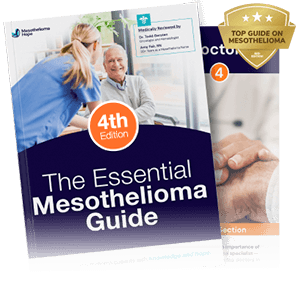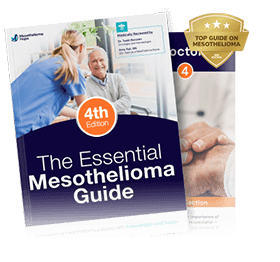Mesothelioma is a rare cancer caused by exposure to asbestos. Female patients account for nearly 25% of the 3,000 mesothelioma cases diagnosed each year but still may face difficulties getting an accurate diagnosis.
The aggressive cancer is more commonly associated with men in occupations that have a high risk of asbestos exposure. For this reason, when women seek medical care for their symptoms, their condition may be mistaken for other less serious issues.
It takes 65% more time for women to receive a mesothelioma diagnosis than men — 152 days for women compared to 92 for men — according to a 2022 study published in BMJ Open Respiratory Research.
A recent case study published in Cureus highlights the story of a 56-year-old woman with a rare presentation of mesothelioma. Initially, her dry cough and shortness of breath were attributed to asthma because she had no known occupational exposure to asbestos.
After many visits to the emergency room, imaging scans, and biopsies, doctors confirmed she had pleural mesothelioma, a type of mesothelioma that develops in the lung lining. Her case highlights the need for vigilance when diagnosing women, especially those outside of the typical patient profile for mesothelioma.
Shared Fight for an Accurate Mesothelioma Diagnosis
Sadly, this patient’s case study is not the only story of women fighting for an accurate mesothelioma diagnosis.
Several factors contribute to the longer waits women may experience when getting diagnosed. One of the main reasons is women are not the typical demographic for mesothelioma: men around 75 years old with a history of work-related asbestos exposure.
Mesothelioma Symptoms in Women: Difficult to Pinpoint Cause
Common symptoms of mesothelioma, like a persistent cough or shortness of breath, may present for both men and women with mesothelioma.
However, some women with mesothelioma may present with symptoms that are sometimes dismissed, including:
- Abdominal bloating and digestive changes: A mesothelioma patient named Julie Gundlach was told by her doctors that she likely had ovarian cancer due to her digestive issues. However, after the surgery to remove the tumor in her abdomen, doctors realized she had peritoneal mesothelioma.
- Fluid build-up (effusion) around the heart, lungs, or abdomen: One 35-year-old woman kept receiving treatments for effusions around her heart, lungs, and abdomen. It took another year for her to receive a rare pericardial mesothelioma diagnosis, according to a 2023 study published in Radiology Case Reports.
- Heavy menstrual bleeding: A 37-year-old woman experienced painful and heavy menstrual periods for 3 months. Imaging scans revealed thickened tissue in her abdomen and a growth that was later confirmed to be peritoneal mesothelioma, based on a March 2022 Case Reports in Oncology article.
- Night sweats: Another patient, Mary Jane Williams, went to several doctors who didn’t connect her symptoms of swelling and sweating to mesothelioma. It wasn’t until gallbladder surgery that she received her diagnosis and began treatment.
These symptoms can be difficult for doctors to connect to mesothelioma because they may not have familiarity with the rare cancer’s presentation in women.
Need help finding a mesothelioma specialist near you? Try our Free Doctor Match service now to have us connect you with local specialists who can provide a timely diagnosis.
Asbestos Exposure in Women
Just because someone doesn’t have a history of occupational asbestos exposure doesn’t mean they haven’t been exposed to asbestos in another setting.
The patient in this case study didn’t have any occupational asbestos exposure. However, she was a school principal, an occupation that could be at risk of asbestos exposure due to asbestos used in school construction materials.
In fact, reports estimate that 15 million students and 1.4 million teachers may still be at risk of asbestos exposure, leading to some teachers protesting the asbestos hazards in their schools.
Women may also be exposed to asbestos if their older home was built with asbestos-containing construction materials or even secondhand when spouses or parents bring asbestos fibers on their work clothes or uniforms.
Asbestos was used so heavily in construction materials until the 1980s that an estimated 25 million homes may still contain asbestos and put people at risk of exposure.
The Centers for Disease Control and Prevention reported in 2020 that nearly 23% of women who died from mesothelioma were stay-at-home wives and mothers.
The case study highlighted in the Cureus report is proof that doctors need to expand their typical perception of mesothelioma cases to include both younger and female patients.
How We Can Help You Get an Accurate Diagnosis
Mesothelioma Hope has seen firsthand how difficult it can be for patients, especially women, to receive a timely mesothelioma diagnosis.
Early detection of mesothelioma is critical to improve mesothelioma treatment outcomes and extend your life.
Our team is here to help. We can get you in touch with top mesothelioma specialists in your area so you can get a second opinion. Our Patient Advocates also have access to databases that can help them pinpoint where you might have been exposed to asbestos.
Contact us now to get started.











